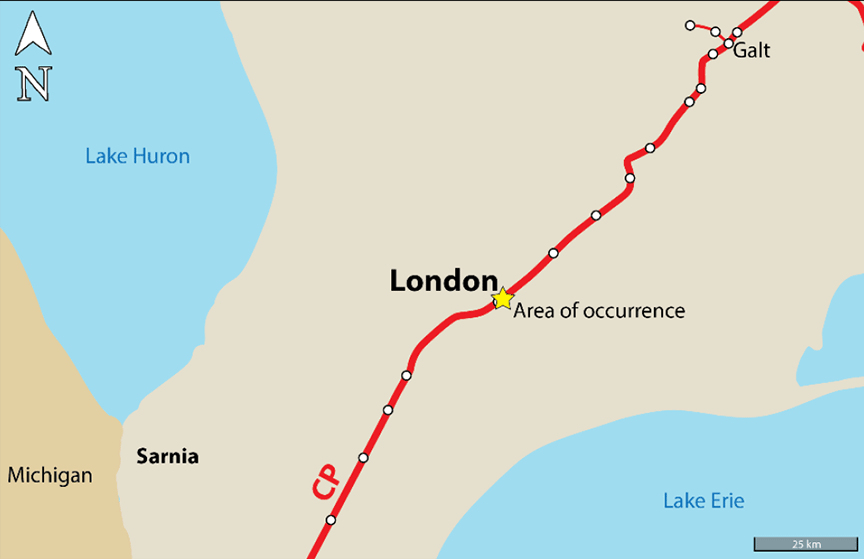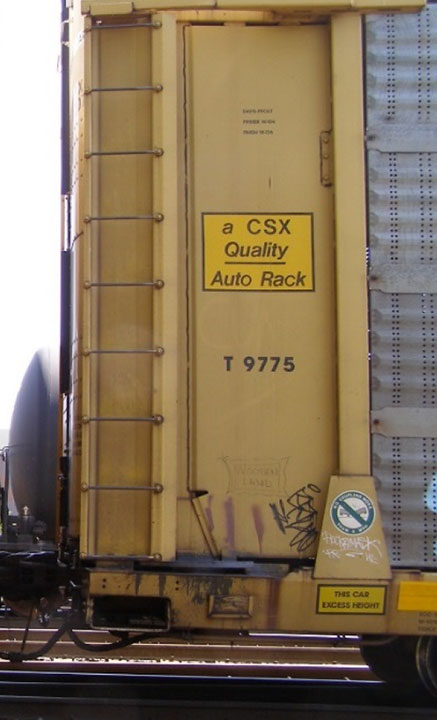Employee injury
Canadian Pacific Railway
Freight train 141-30
Mile 113.0, Galt Subdivision
London, Ontario
The Transportation Safety Board of Canada (TSB) investigated this occurrence for the purpose of advancing transportation safety. It is not the function of the Board to assign fault or determine civil or criminal liability. This report is not created for use in the context of legal, disciplinary or other proceedings. See Ownership and use of content. Masculine pronouns and position titles may be used to signify all genders to comply with the Canadian Transportation Accident Investigation and Safety Board Act (S.C. 1989, c. 3).
The occurrence
At 0530Footnote 1 on 31 July 2017, the crew of Canadian Pacific Railway (CP) conventional freight train 141-30 had just completed the setout of 35 cars at CP's Quebec Street Yard in London, Ontario (Figure 1). The crew members (a conductor and a locomotive engineer [LE]) were fit for service, qualified for their respective positions, and familiar with the subdivision.
At the time of the occurrence, the sky was dark and there was no additional lighting along the railway right-of-way.
Following the set out, the movement then consisted of 5 locomotives and 33 loaded cars. It weighed about 3400 tons and was 3378 feet long. The 33 loaded cars on the movement were tri-level auto carriers equipped with end-of-car cushioning devices (EOCCDs).Footnote 2
Upon receiving a permissive signal indication, the crew pulled the movement westward back onto the main track and then reversed eastward to couple back onto the standing portion of the train. The movement was ascending a 1.6% grade at approximately 9 mph, with the throttle in position 1 and the brakes released.
The conductor was correctly positioned on the north side of the lead car and was riding the ladder (Figure 2). The conductor was providing radio instructions to the LE, who was in the controlling locomotive, about 3300 feet away. As an additional safety measure, the conductor advised the LE when the leading car reached a predetermined "1 mile" to the location of the intended coupling, so the LE could set the locomotive distance counter.
Over the next 5 minutes, the conductor followed normal protocol for calling distance to couple. About 25 seconds after the conductor radioed "30 cars," the LE advised the conductor that the distance counter was indicating 1000 feet to go. Almost immediately, the conductor told the LE to stop the movement. Unknown to the LE, the head end of the movement had encountered thick brush along the railway right-of-way (Figure 3). The thick brush rubbed against the side of the car, making it difficult for the conductor to hold on to the car.
Perceiving the need to respond quickly, the LE closed the throttle and attempted to apply the train brakes in emergency. However, the train brake handle was obstructed by the radio cord; the radio handset had been placed nearby for convenience. The train brake handle stopped in the handle-off position (i.e., one position short of emergency).
In this position, the train brakes continued to apply at a more gradual service rate, but did not go into emergency. The independent brakes on all 5 locomotives were allowed to fully apply.Footnote 3 While the brakes were applying, the conductor made a second, more urgent request to stop the movement.
The movement stopped quickly, producing a rapid run-out of slack that cascaded toward the conductor's location on the lead car. When the run-out reached the lead car, the conductor, who was still being affected by the thick brush, was thrown sideways and lost footing and grip on the ladder. The conductor fell off the lead car to the field side of the track, injuring his left leg. The conductor then radioed for help, indicating that his leg was broken. The radio message was overheard by the rail traffic controller in Calgary, Alberta, who immediately coordinated the emergency response. London-Middlesex Emergency Medical Services transported the conductor to the hospital.
Vegetation control at Canadian Pacific Railway
CP operates a regional brush removal and suppression program that plans activities based on regional growing characteristics. Areas with high precipitation and long growing seasons, such as southwestern Ontario, have targeted treatment rotations of 2 to 3 years. The scheduling of the regional program also considers information provided by local track patrol personnel and other parties, such as train crews.
At local health and safety committee meetings, vegetation control issues are often discussed, resulting in follow-up remediation. For example, during the June 2017 meeting, brush obstructions at Wentworth Street South (Hamilton, Ontario) were reported as being potentially unsafe: the brush made it difficult for train crews to observe a signal and for crew members to ride the side of equipment.
Since March 2017, at least 6 discussions had been held relating to grass, weeds, brush, and tree obstructions within the region, with 1 discussion related to vegetation encroaching in a manner that could have an impact on employees riding on the side of a car. The accident location was not specifically mentioned during the health and safety committee meetings. However, Google Street View captures from September 2015 (Figure 4) and July 2016 indicated that there had previously been heavy vegetation in the vicinity of the occurrence.
In the area of the accident, brush suppression work had been scheduled to start on 13 June 2017. However, local engineering forces were engaged in track maintenance at that time and could not provide protection for the brush-cutting contractor. As a result, the work was deferred and the contractor was reassigned. At the time of the occurrence, brush removal activities had not yet been rescheduled at the occurrence location.
During post-occurrence examination of the site, more than 370 feet of continuous dense brush was present along the north side of the railway right-of-way, encroaching to within about 2 feet of the north rail. When riding the side of a typical rail car, a crew member would be positioned several feet beyond the field side of the rail.
Locomotive engineer's response to the emergency situation
In response to the conductor's unexpected radio instruction to stop, the LE believed that there was an emergency, but did not know the nature of that emergency. The LE had to quickly perform a sequence of actions under pressure, including initiating emergency braking. However, the train brake was inadvertently engaged to one position short of the emergency position (in the "handle-off" position). In addition, the independent brake was applied, but without being bailed off to limit the build-up of in-train forces. Therefore, the locomotives on the movement came to a stop more quickly, but the quick stop on the ascending grade generated the elevated slack run-out in the EOCCD-equipped cars.
CP expects its operating crews to employ good train handling when operating and to correctly apply the General Operating Instructions (GOI) at all times, even during emergency situations. Section 1, item 37.2, of the GOI states the following:
Footnote 4Item 37.4 states the following:
Footnote 5Previous occurrence involving vegetation control protocols
In 2012, the TSB conducted an investigation into a crossing accident in Broadview, Saskatchewan (TSB Railway Investigation Report R12W0182). The investigation determined that, despite a well-developed vegetation control protocol at CP, brush-cutting activities in the vicinity of the crossing had not been completed before the brush became an obstruction. The obstruction was determined to be one of the factors contributing to the Broadview accident.
Safety message and actions taken
Following this occurrence in London, CP immediately sent out a system bulletin to warn operating crews of the vegetation obstruction. Brush was then cleared in the area of the accident.
CP has continued to explore new technologies to increase the effectiveness of its vegetation control program such as the "SkyTrim." The "SkyTrim" is a truck with a telescoping arm that has a saw blade on the end to remove whole branches that could interfere with signal sight lines or make contact with passing trains.
On 07 September 2017, the TSB issued a Rail Safety Advisory letter (RSA 11/17) to Transport Canada, indicating that Transport Canada may wish to review CP's brush-cutting practices to ensure that vegetation along the right-of-way does not encroach upon the track and become a safety hazard.
When vegetation control programs are not completed in a timely manner, vegetation obstructions along the railway right-of-way might not be addressed until they have compromised safe railway operations.
This concludes the TSB's limited-scope investigation into this occurrence. The Board authorized the release of this investigation report on . It was officially released on 23 April 2018.



